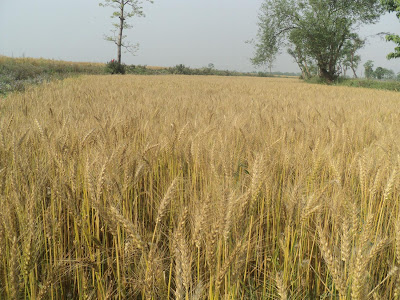Wheat
is ready for harvest but, sadly, field mice are the ones which harvested the
crop first. I had been delighted to see the good crop but thorough inspection
revealed the empty patches at the center of the field with numerous burrows
surrounded by stiff stubbles. I was obviously disappointed to notice hard grown
grains being looted by marauders.
After
the rice season, there were two options, wheat or mustard to grow in my land. I
preferred wheat for two reasons. Mustard had been marred by severe weather last
season. Accordingly many farmers, especially ones who grew mustard, suffered
heavy loss. Unlike wheat, mustard does not prefer much rain. The other reason
is scarcity of wheat, one of the ingredients to make satu (food for school
children supplied by Books for Nepal), last year. I thought of easy
accessibility of wheat to make satu when I grow it in my land.
Almost
all neighboring farmers grew mustard that had been already harvested. To their
delight, weather turned out to be fine resulting excellent yield. There was not
much rain as expected but wheat is also good this season, as we took good care.
Tractor
ploughed the land couple of times before wheat seeds were sown. Birds (crow,
starlings and drongos) fed on seeds which were not covered by earth. They
continue to feed on seeds until the seedlings is about 4-5 inch long. A person
was appointed for more than a week to chase the birds away. The field was well
irrigated using the pump set, and pesticide and fertilizers were spread. Brief
rain shower when the plant starts to bear grains was much helpful for the crop.
Along
the mustard, wheat was also doing well until this unexpected enemy lurking around
inside field. Two plots of rear end heavily destroyed by the mice. To intercept
their further advancing, poison was mixed with tiny fish and spread these on
their way and holes. This is not much effective because whole battalion of mice
is on the raid. Because there is no wheat field around, all the mice assembled
in my land for easy accessibility of food and shelter. The damage would have
been minimal had there been same crop around.
I
am not for sure but I think population of mice is ever increasing. This could
be attributed to the fact that Tharu people now avoid consuming meat of field
mouse. They used to eat mouse and some of old people still eat them, but new
generation gradually give up this old practice. I remember how Tharu
people dig the burrows in harvested field to extract both mice and stored
grains (wheat or rice) from their citadels.
As
the wheat is harvested by harvester, not much labor work is required. My only
concern is weather. This time of the year is involved with occasional squally
showers. I am praying for good weather during harvesting of wheat.

mtefr2396ca
ReplyDeletegolden goose outlet
golden goose outlet
golden goose outlet
supreme outlet
golden goose outlet
golden goose outlet
golden goose outlet
golden goose outlet
golden goose outlet
golden goose outlet